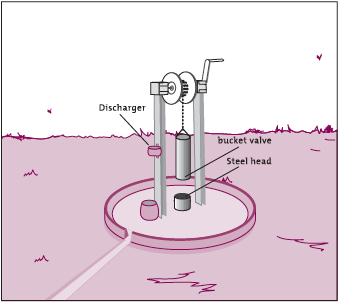Difference between revisions of "Bucket pump"
From Akvopedia
| Line 2: | Line 2: | ||
[[Image:bucket pump icon.png|right]] | [[Image:bucket pump icon.png|right]] | ||
[[Image:BucketPump.jpg|thumb|right|300px|Bucket Pump. Photo: WHO.]] | [[Image:BucketPump.jpg|thumb|right|300px|Bucket Pump. Photo: WHO.]] | ||
| + | |||
| + | The bucket pump is mainly used in drilled wells. It consists of a windlass over a 125 mm PVC tube, down which a narrow bucket with a valve in the base is lowered into the water on a chain. When the bucket hits the water, the valve opens and the water flows in. When the bucket is raised, the valve closes and the water is retained in the bucket. To release the water, the pump operator rests the bucket on a water discharger, which opens the valve in the base. The windlass bearings are made of wood. | ||
Revision as of 02:24, 11 July 2012
| |
The bucket pump is mainly used in drilled wells. It consists of a windlass over a 125 mm PVC tube, down which a narrow bucket with a valve in the base is lowered into the water on a chain. When the bucket hits the water, the valve opens and the water flows in. When the bucket is raised, the valve closes and the water is retained in the bucket. To release the water, the pump operator rests the bucket on a water discharger, which opens the valve in the base. The windlass bearings are made of wood.

